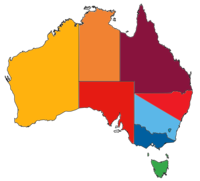Related Research Articles
The Football Federation South Australia 2013 season was the first season under the new competition format in South Australia. The competition consists of two divisions across the State of South Australia, created from the teams in the previous three tier structure: the National Premier Leagues South Australia and the FFSA State League.
The Football Federation South Australia 2011 season was the sixth season under the previous competition format in South Australia. The competition consisted of three divisions across the State of South Australia.
The Football Federation South Australia 2010 season was the fifth season under the previous competition format in South Australia. The competition consisted of three divisions across the State of South Australia.
The Football Federation South Australia 2006 season was the first season ran by the Football Federation of South Australia, which replaced the South Australian Soccer Federation. The competition consisted of three divisions across the State of South Australia. The top division of association football was the South Australian Super League, replacing the South Australian Premier League, which became the second division.
The Football Federation South Australia 2009 season was the fourth season under the previous competition format in South Australia. The competition consisted of three divisions across the State of South Australia.
The Football Federation South Australia 2008 season was the third season under the previous competition format in South Australia. The competition consisted of three divisions across the State of South Australia.
The Football Federation South Australia 2007 season was the second season under the previous competition format in South Australia. The competition consisted of three divisions across the State of South Australia.
The Football Federation South Australia 2014 season was the second season under the new competition format in South Australia. The competition consists of two divisions across the State of South Australia. The overall premier for the new structure qualified for the National Premier Leagues finals series, competing with the other state federation champions in a final knockout tournament to decide the National Premier Leagues Champion for 2014.
The 2014 Northern NSW Football season was the first season under the new competition format in northern New South Wales. The competition consisted of six divisions across the district. The overall premier for the new structure qualified for the National Premier Leagues finals series, competing with the other state federation champions in a final knockout tournament to decide the National Premier Leagues Champion for 2014.
The Football Federation Tasmania 2015 season was the third season under the new competition format in Tasmania. The competition consists of three major divisions across the State of Tasmania, created from the teams in the previous structure. The overall champion for the new structure qualified for the National Premier Leagues finals series, competing with the other state federation champions in a final knockout tournament to decide the National Premier Leagues Champion for 2015.
The 2016 Football Federation South Australia season was the fourth season under the National Premier Leagues competition format in South Australia. The league was restructured, moving from a 2 tiered system to a 3 tiered system with the introduction of a new 3rd division.
The 2016 Football Queensland season was the fourth season since NPL Queensland commenced as the top tier of Queensland men’s football. Below NPL Queensland is a regional structure of ten zones with their own leagues. The strongest of the zones is Football Brisbane with its senior men’s competition consisting of five divisions.
The 2017 Football Federation South Australia season was the fifth season under the National Premier Leagues competition format in South Australia.
The 2017 Football Federation Victoria season was the fourth season under the new competition format for state-level football (soccer) in Victoria. The competition consists of seven divisions across the state of Victoria.
The 2017 Football Queensland season was the fifth season since NPL Queensland commenced as the top tier of Queensland men’s football. Below NPL Queensland was a regional structure of ten zones with their own leagues. The strongest of the zones was Football Brisbane with its senior men’s competition consisting of five divisions.
The 2018 Football Queensland season was the sixth season since NPL Queensland commenced as the top tier of Queensland men's football. This season was also the initial season of the Football Queensland Premier League which occupied the second tier in Queensland men's football in 2018.
The 2018 Football Federation South Australia season was the sixth season under the National Premier Leagues competition format in South Australia.
The 2019 FFSA season was the seventh season under the competition format in Football South Australia.
The 2019 Football Queensland season was the seventh season since NPL Queensland commenced as the top tier of Queensland men’s football. This season was also the second season of the Football Queensland Premier League which occupied the second tier in Queensland men’s football in 2019.
The 2020 FFSA season was the eighth season under the competition format in Football South Australia.
References
- ↑ "South Australian Super League 2012 - Fixtures" . Retrieved 22 September 2012.
- ↑ "South Australian Premier League 2012 - Fixtures" . Retrieved 14 May 2014.
- ↑ "South Australian State League 2012 - Fixtures" . Retrieved 15 May 2014.
